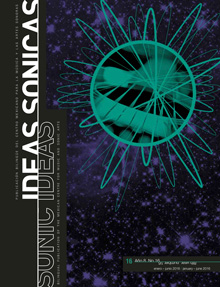¿Cómo se dice "Ambisonic Toolkit" en Español?
Posted
by Joseph Anderson

This was the question posed to the ATK team by Prof. Oscar Pablo Di Liscia, editor of the latest issue of Ideas Sónicas / Sonic Ideas. The first answer back: “Me llamo José…. pero, no hablo Español muy bien.” (Yeah, while I can say my name in Spanish, that’s not exactly good enough!) Luckily, we have Lucas Samaruga to thank for stepping in and offering his translation skills.
From Di Liscia’s introducción:
El artículo de Joseph Anderson y Trond Lossius (publicado aquí tanto en su versión original en Inglés como en su version en Español, esta última gracias a la traducción de Lucas Samaruga) presenta la implementación de un conjunto de herramientas de software para el trabajo con la técnica Ambisonics (ATK, Ambisonic Toolkit) en un entorno que la hace más accesible a músicos familiarizados con DAWs (Digital Audio Workstations), en este caso, Reaper. Si bien su enfoque es eminentemente técnico, sus autores destacan que ATK “…permite e impulsa al compositor a pensar más allá de la ubicación del sonido en un espacio sonoro y, en cambio, atender a la impresión e imagen de un campo sonoro”. La concepción es sutil, pero significativa, y marca una diferencia con el uso tradicional de la espacialización por lo general presente en mucha música electroacústica y producción sonora de la industria.
And then… in English:
The article by Joseph Anderson and Trond Lossius (published here in both English and Spanish, the latter version made possible thanks to a translation by Lucas Samaruga) presents the implementation of a set of software tools to work with the Ambisonics technique (ATK, Ambisonic Toolkit) in an environment that makes it more accessible to musicians that are familiar with DAWs (Digital Audio Workstations), in this case Reaper. Although its approach is mainly technical, its authors point out that ATK “…allows and encourages the composer to think beyond the placement of sounds in a sound-space and instead attend to the impression and image of a soundfield.” The concept is subtle but significant, and is in contrast to the traditional use of spatialisation generally present in many electro acoustic music and industry sound production.
Subtle but significant
That’s the big difference in working with the Ambisonic Toolkit over other spatial sound toolsets. The model isn’t placing sounds in space, but instead, shaping the sound of space. Yeah, that’s something of a head shift. (I think of it like being some sort of god of space, looking in, shaping space as if it were a ball of clay.) That’s where the true power of the Ambisonic technique lies.
We’re excited about bringing these tools and ideas to a Spanish language audience in Sonic Ideas/Ideas Sónicas Año 8 No. 16/Vol. 8 No. 16. The original English language version is also published here, too… so those of us who no hablo Español muy bien can also aspire to a spatial god-like stature, too!
